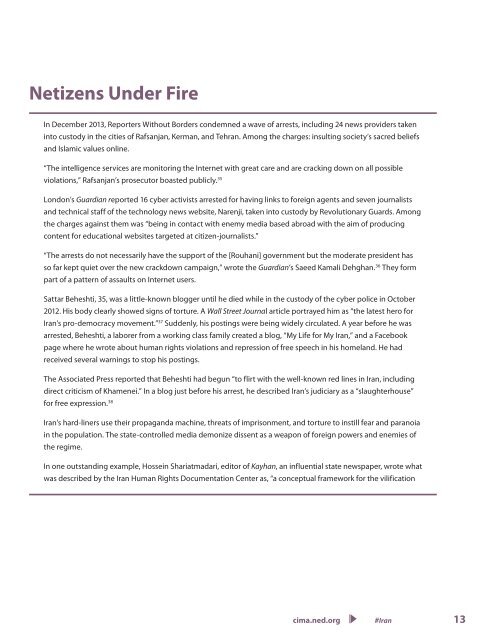CIMA-Iran
CIMA-Iran
CIMA-Iran
- No tags were found...
You also want an ePaper? Increase the reach of your titles
YUMPU automatically turns print PDFs into web optimized ePapers that Google loves.
Netizens Under FireIn December 2013, Reporters Without Borders condemned a wave of arrests, including 24 news providers takeninto custody in the cities of Rafsanjan, Kerman, and Tehran. Among the charges: insulting society’s sacred beliefsand Islamic values online.“The intelligence services are monitoring the Internet with great care and are cracking down on all possibleviolations,” Rafsanjan’s prosecutor boasted publicly. 35London’s Guardian reported 16 cyber activists arrested for having links to foreign agents and seven journalistsand technical staff of the technology news website, Narenji, taken into custody by Revolutionary Guards. Amongthe charges against them was “being in contact with enemy media based abroad with the aim of producingcontent for educational websites targeted at citizen-journalists.”“The arrests do not necessarily have the support of the [Rouhani] government but the moderate president hasso far kept quiet over the new crackdown campaign,” wrote the Guardian’s Saeed Kamali Dehghan. 36 They formpart of a pattern of assaults on Internet users.Sattar Beheshti, 35, was a little-known blogger until he died while in the custody of the cyber police in October2012. His body clearly showed signs of torture. A Wall Street Journal article portrayed him as “the latest hero for<strong>Iran</strong>’s pro-democracy movement.” 37 Suddenly, his postings were being widely circulated. A year before he wasarrested, Beheshti, a laborer from a working class family created a blog, “My Life for My <strong>Iran</strong>,” and a Facebookpage where he wrote about human rights violations and repression of free speech in his homeland. He hadreceived several warnings to stop his postings.The Associated Press reported that Beheshti had begun “to flirt with the well-known red lines in <strong>Iran</strong>, includingdirect criticism of Khamenei.” In a blog just before his arrest, he described <strong>Iran</strong>’s judiciary as a “slaughterhouse”for free expression. 38<strong>Iran</strong>’s hard-liners use their propaganda machine, threats of imprisonment, and torture to instill fear and paranoiain the population. The state-controlled media demonize dissent as a weapon of foreign powers and enemies ofthe regime.In one outstanding example, Hossein Shariatmadari, editor of Kayhan, an influential state newspaper, wrote whatwas described by the <strong>Iran</strong> Human Rights Documentation Center as, “a conceptual framework for the vilificationcima.ned.org #<strong>Iran</strong> 13


